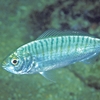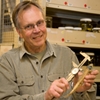General Description
Body depressed anteriorly; head depressed, dorsal surface slightly convex to flat in profile; mouth directed slightly upwards when closed; scales covering most of head, but absent from front of pectoral-fin base. Sandy coloured, scales outlined in pale green, grey or brown on top, underside paler. To 11 cm.
Biology
These fishes bury in sand leaving only eyes exposed to escape predation and await prey. Cirri prevent sand entering mouth and gill cavities while the fish is buried. They are relatively common off sandy beaches, although rarely seen.
Habitat
Shallow, clear sandy areas with high turbulence in bays and along the coast, in depths of 0-20 m.
Soft substrates
Distribution guide
Southern Australia.
Species Group
Depth
Shore (0-1 m)
Shallow (1-30 m)
Water Column
Max Size
11 cm
Commercial Species
No
Global Dispersal
Native to Australia
Conservation Status
- DSE Advisory List : Not listed
- EPBC Act 1999 : Not listed
- IUCN Red List : Not listed





